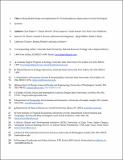Files in this item
Linking model design and application for transdisciplinary approaches in social-ecological systems
Item metadata
| dc.contributor.author | Steger, Cara | |
| dc.contributor.author | Hirsch, Shana | |
| dc.contributor.author | Cosgrove, Chris | |
| dc.contributor.author | Inman, Sarah | |
| dc.contributor.author | Nost, Eric | |
| dc.contributor.author | Shinbrot, Xoco | |
| dc.contributor.author | Thorn, Jessica Paula Rose | |
| dc.contributor.author | Brown, Daniel | |
| dc.contributor.author | Gret-Regamey, Adrienne | |
| dc.contributor.author | Muller, Birgit | |
| dc.contributor.author | Reid, Robin | |
| dc.contributor.author | Tucker, Catherine M. | |
| dc.contributor.author | Klein, Julia A. | |
| dc.contributor.author | Weibel, Bettina | |
| dc.date.accessioned | 2022-02-08T11:30:14Z | |
| dc.date.available | 2022-02-08T11:30:14Z | |
| dc.date.issued | 2021-01-01 | |
| dc.identifier | 277724395 | |
| dc.identifier | 75144166-9121-4d8e-a75a-8148ee8f3ebe | |
| dc.identifier | 85098093965 | |
| dc.identifier.citation | Steger , C , Hirsch , S , Cosgrove , C , Inman , S , Nost , E , Shinbrot , X , Thorn , J P R , Brown , D , Gret-Regamey , A , Muller , B , Reid , R , Tucker , C M , Klein , J A & Weibel , B 2021 , ' Linking model design and application for transdisciplinary approaches in social-ecological systems ' , Global Environmental Change , vol. 66 , 102201 . https://doi.org/10.1016/j.gloenvcha.2020.102201 | en |
| dc.identifier.issn | 0959-3780 | |
| dc.identifier.other | RIS: urn:0616F4F5C6DFB6C83A14FFAE647D7995 | |
| dc.identifier.other | ORCID: /0000-0003-2108-2554/work/117568938 | |
| dc.identifier.uri | https://hdl.handle.net/10023/24822 | |
| dc.description | This work was supported by the US National Science Foundation through the Mountain Sentinels Research Coordination Network (NSF #1414106), the Swiss National Science Foundation through MtnPaths – Pathways for global change adaptation of mountain socio-ecological systems (#20521L_169916), and the Center for Collaborative Conservation at Colorado State University. | en |
| dc.description.abstract | As global environmental change continues to accelerate and intensify, science and society are turning to trans- disciplinary approaches to facilitate transitions to sustainability. Modeling is increasingly used as a technological tool to improve our understanding of social-ecological systems (SES), encourage collaboration and learning, and facilitate decision-making. This study improves our understanding of how SES models are designed and applied to address the rising challenges of global environmental change, using mountains as a representative system. We analyzed 74 peer-reviewed papers describing dynamic models of mountain SES, evaluating them according to characteristics such as the model purpose, data and model type, level of stakeholder involvement, and spatial extent/resolution. Slightly more than half the models in our analysis were participatory, yet only 21.6% of papers demonstrated any direct outreach to decision makers. We found that SES models tend to under-represent social datasets, with ethnographic data rarely incorporated. Modeling efforts in conditions of higher stakeholder diversity tend to have higher rates of decision support compared to situations where stakeholder diversity is absent or not addressed. We discuss our results through the lens of appropriate technology, drawing on the concepts of boundary objects and scalar devices from Science and Technology Studies. We propose four guiding principles to facilitate the development of SES models as appropriate technology for transdisciplinary applications: (1) increase diversity of stakeholders in SES model design and application for improved collaboration; (2) balance power dynamics among stakeholders by incorporating diverse knowledge and data types; (3) promote flexibility in model design; and (4) bridge gaps in decision support, learning, and communication. Creating SES models that are appropriate tech- nology for transdisciplinary applications will require advanced planning, increased funding for and attention to the role of diverse data and knowledge, and stronger partnerships across disciplinary divides. Highly contextualized participatory modeling that embraces diversity in both data and actors appears poised to make strong contributions to the world’s most pressing environmental challenges. | |
| dc.format.extent | 14 | |
| dc.format.extent | 876906 | |
| dc.language.iso | eng | |
| dc.relation.ispartof | Global Environmental Change | en |
| dc.subject | Dynamic modeling | en |
| dc.subject | Transdisciplinarity Science and technology studies | en |
| dc.subject | Knowledge co-production | en |
| dc.subject | Mountain social-ecological systems | en |
| dc.subject | Mutual learning | en |
| dc.subject | G Geography (General) | en |
| dc.subject | 3rd-DAS | en |
| dc.subject.lcc | G1 | en |
| dc.title | Linking model design and application for transdisciplinary approaches in social-ecological systems | en |
| dc.type | Journal article | en |
| dc.contributor.institution | University of St Andrews. School of Geography & Sustainable Development | en |
| dc.identifier.doi | https://doi.org/10.1016/j.gloenvcha.2020.102201 | |
| dc.description.status | Peer reviewed | en |
| dc.date.embargoedUntil | 2021-12-17 | |
| dc.identifier.url | https://pure.york.ac.uk/portal/en/publications/linking-model-design-and-application-for-transdisciplinary-approaches-in-socialecological-systems(a7f130d4-34ad-49de-8a45-6c7c4e1dff26).html | en |
This item appears in the following Collection(s)
Items in the St Andrews Research Repository are protected by copyright, with all rights reserved, unless otherwise indicated.

